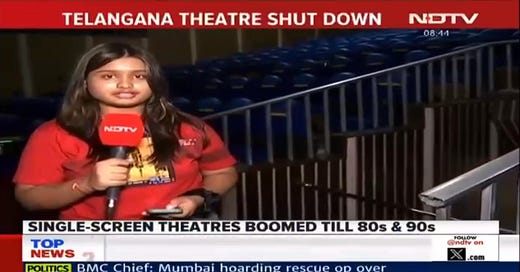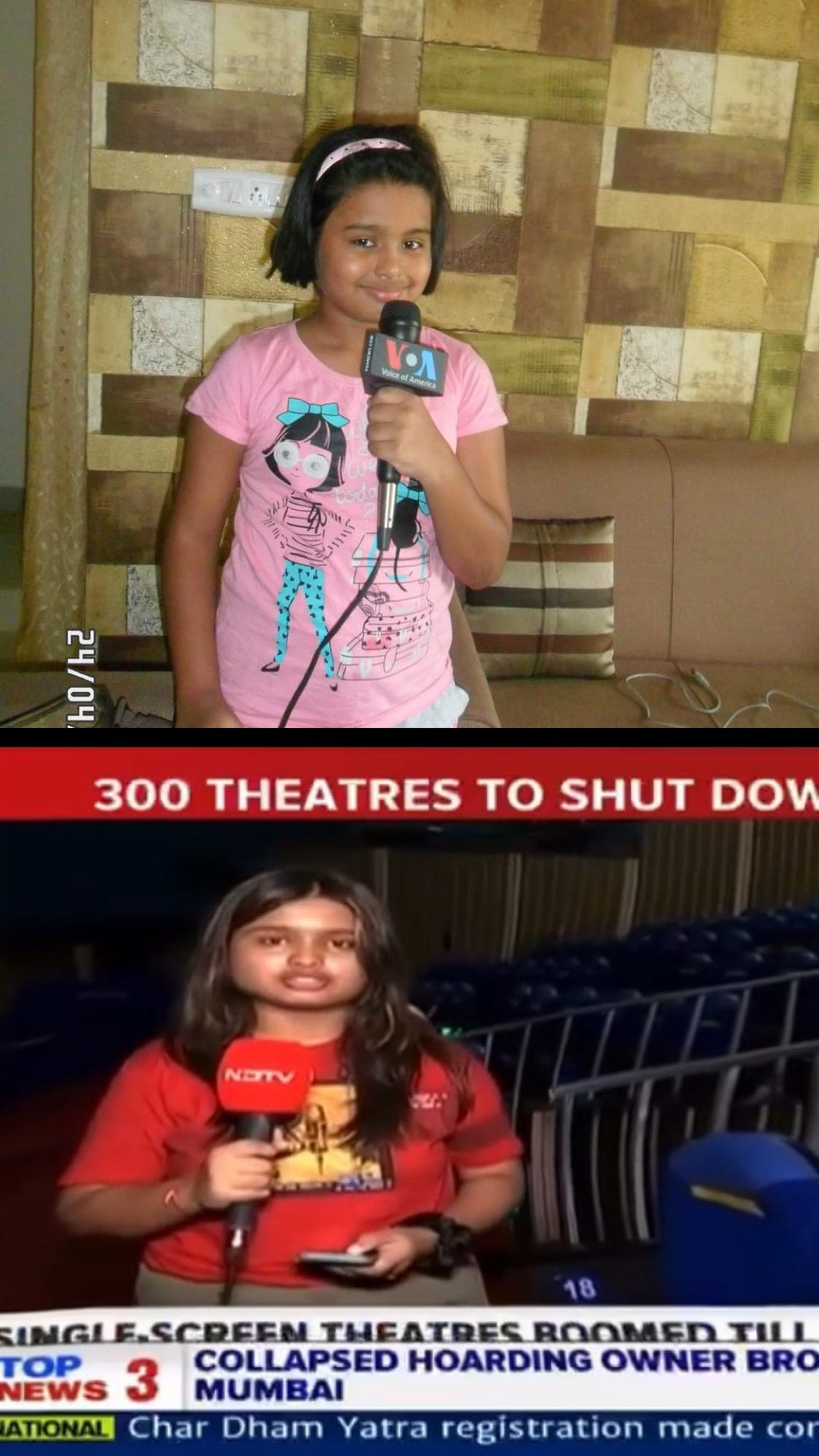Hello, everyone! Been a while but I am back with some great news!
As an intern at NDTV for the past month, I have embarked on an incredible journey of learning and discovery. Recently, a story I worked on made it to air, and I wanted to bring you along on this fascinating process.
The Telangana Theatres Association recently announced the closure of single screens across the state for ten days due to low audience turnout. Their statement cited a lack of notable movie releases and lower-than-expected attendance for current films.
Assigned this story, I was excited as a media enthusiast. It was a refreshing change from the political news I had been focusing on during the elections.
In the golden era of the 1960s and 1970s, single-screen theatres were the epicentres of entertainment, filled with audiences eager to watch the megastars of that time, as I had heard from all the adults in my life. However, the 2020s have not been as kind to these cinematic sanctuaries. I don’t think I had ever been to a single-screen theatre before covering this story.
To delve deeper, I visited Devi Theatre, one of the oldest and biggest single-screen theatres in Hyderabad, and spoke with the owner, Raj Tadla, for a case study. Raj was generous with his time, patiently sharing details and answering my questions with keen interest.
Devi Theatre, which has a capacity of 1400, hosted a movie attended by only 20 people on the day of my visit. Established in 1975 by his father, Raj has modernized its equipment to provide a good viewing experience despite its old-timey exterior.
In 2017, Devi Theatre won the award for Best Single Screen in India at the Big Cine Expo. Raj was pleasantly surprised to learn that the recognition was based on YouTube comments, showcasing the love audiences still have for these films and the traditional spaces they occupy. There is an emotional attachment to these spaces. A group of young boys I spoke to at the theatre mentioned that this is the space where they can express and enjoy a movie loudly. This demonstrates the theatres' adaptation to modern tastes while retaining their classic charm. Raj mentioned that despite the challenges, single-screen theatres are determined to continue in the face of the convenience and adaptability of digital platforms. Single-screen theatres have witnessed technology evolve around media and yet somehow manage to remain relevant when a movie in its purest form needs to be experienced by movie enthusiasts.
This raises several questions about the low turnouts and the decline of single-screen theatres: Is it the multitude of entertainment options available to audiences today? The rising temperatures? The rise of multiplexes? Or perhaps the waning support from producers? A decline in the art of cinema?
Raj pointed out that summer heat, in fact, encourages people to seek refuge in air-conditioned halls to catch a blockbuster.
In a brief call with Vijendra Reddy, the president of the Theatre Exhibitors Association, he noted that audiences have become more discerning. While there is a clear distinction between OTT watchers and movie theatre-goers, the issue arises when regular moviegoers decide not to attend. People are pickier with movies now, often judging them by trailers and teasers. Even big names aren’t drawing crowds to theatres as much as before. Reddy also mentioned that elections and the IPL are regular occurrences, so what does this trend say about our movie industry, particularly Tollywood, which is second only to Bollywood in size?
I have to admit, I too don’t go to theatres as often. It’s convenient to watch movies on my screen at home, and only after careful consideration of trailers and teasers do I decide to watch a film on the big screen. If my judgment proves wrong, I’m even less inclined to return to theatres.
Through this research and conversations with various stakeholders, I learned about the financial strain single-screen theatres face. Immense losses due to unfair percentage sharing in the Telugu-speaking states have prompted many theatres to upgrade to multiplexes for the benefits. Single-screen theatres receive a meagre amount, about 1/5th of what multiplexes get, due to their limited bargaining power. This disparity is a significant reason for their struggle. Out of the 450 theatres, almost 80% were to be closed according to Vijendra Reddy, and producers financially support those that remain open to keep running on their accord. This sets a wrong precedent for our film industry.
There is significant anger over this disparity, and the conversation around single-screen versus multiplex theatres is ongoing. Theatre owners are requesting subsidized electricity rates and the ability to play other content besides movies. Imagine watching an IPL match streamed live from a movie theatre with a 1000-seat capacity or a streamed stand-up comedy special. These spaces could serve as alternate venues during lulls in cinema, adapting just like digital platforms can.
Although I studied TV production and even worked on a bulletin in my previous semester, this story presented unique challenges. Structuring a story is something I am still coming to terms with, despite having this newsletter for the past five years. It’s an aspect I am all too unfamiliar with.
The art of interviewing is something I will forever be intrigued by. It’s what drives me to pursue media – the ability to dive deep into a person’s mind and thoughts through questions, what can be said, and how much there is to be said. Even with thorough preparation, interviews often unfold into conversations that reveal more than expected, and I found myself wanting to delve into various moments even further.
Watching this story come together in just a few hours was inspiring and helped me gain respect for this work as it truly is a team effort. I have been fortunate to witness Uma Sudhir and her team work on these stories, making it look almost effortless when I have probably faced my toughest challenge.
I am honoured and humbled by the opportunity to have my story on air, especially my piece to camera in the last 30 seconds. This will always be a moment of pride for me, having my words make it on camera said by me. I might never do this again; who knows what the future holds? It is thrilling to have had this special moment.
The photo below is exactly a decade ago when my uncle, “the media professional” in my family, Deepak Dobhal, came to Hyderabad to cover the Indian elections.
It feels almost like clockwork, holding the mic posing for a picture then to now in real life delivering news holding the news channel microphone.
This experience has been invaluable, reinforcing my passion for media and the stories that shape our world. I look forward to sharing more of my journey with you as I continue to learn and grow at NDTV.
Here, is the video clip of the story,





Liked it. Proud of you. Story of many movie lovers n their feelings
OMG aru I am so proud of u.. Congrats on ur itnern from NDTV and thx for sharing the experience